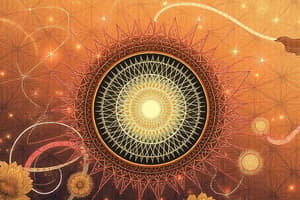Podcast
Questions and Answers
Which joint allows for moving around the transverse axis?
Which joint allows for moving around the transverse axis?
- Saddle joint
- Ball-and-socket joint
- Pivot joint
- Hinge joint (correct)
What type of movement is primarily allowed by a hinge joint?
What type of movement is primarily allowed by a hinge joint?
- Flexion and extension (correct)
- Abduction and adduction
- Rotatory movements
- Circumduction
Which joint is characterized by allowing rotatory movements?
Which joint is characterized by allowing rotatory movements?
- Saddle joint
- Pivot joint (correct)
- Gliding joint
- Hinge joint
What is one function of the deep fascia in relation to muscular contraction?
What is one function of the deep fascia in relation to muscular contraction?
What is one distinguishing characteristic of a pivot joint compared to a hinge joint?
What is one distinguishing characteristic of a pivot joint compared to a hinge joint?
How does negative intra-thoracic pressure contribute to respiratory function?
How does negative intra-thoracic pressure contribute to respiratory function?
Which joint type is best exemplified by the elbow joint?
Which joint type is best exemplified by the elbow joint?
In what way does gravity influence the head and neck region?
In what way does gravity influence the head and neck region?
What is a common characteristic of arterio-venous shunts?
What is a common characteristic of arterio-venous shunts?
Which structure assists in arterial pulsation?
Which structure assists in arterial pulsation?
What does Laplace's law indicate about the relationship between tension and radius in blood vessels?
What does Laplace's law indicate about the relationship between tension and radius in blood vessels?
How does the radius of the ventricles affect the tension during contraction according to Laplace's law?
How does the radius of the ventricles affect the tension during contraction according to Laplace's law?
Which statement correctly reflects the application of Laplace's law in capillaries?
Which statement correctly reflects the application of Laplace's law in capillaries?
What must the heart's ventricles do to elevate intra-ventricular pressure during contraction, based on Laplace's law?
What must the heart's ventricles do to elevate intra-ventricular pressure during contraction, based on Laplace's law?
What formula represents the relationship described by Laplace’s law?
What formula represents the relationship described by Laplace’s law?
At what point does the formation of gametes begin in males?
At what point does the formation of gametes begin in males?
When does gamete formation resume in females after being arrested?
When does gamete formation resume in females after being arrested?
Where does fertilization typically occur?
Where does fertilization typically occur?
Which statement about the timing of gamete formation in males is true?
Which statement about the timing of gamete formation in males is true?
What happens to the formation of female gametes after it begins in the uterus?
What happens to the formation of female gametes after it begins in the uterus?
What is the primary concern expressed in the content regarding interactions with women?
What is the primary concern expressed in the content regarding interactions with women?
What fate is implied for someone who disregards the mention of lawful interactions with women?
What fate is implied for someone who disregards the mention of lawful interactions with women?
Which action is suggested as preferable over engaging with unlawful women?
Which action is suggested as preferable over engaging with unlawful women?
What does the mention of 'head stabbing' imply in the context of unlawful interactions?
What does the mention of 'head stabbing' imply in the context of unlawful interactions?
What overarching theme can be derived from the content regarding gender interactions?
What overarching theme can be derived from the content regarding gender interactions?
Flashcards are hidden until you start studying
Study Notes
Laplace's Law and Capillary Pressure
- Capillaries are able to sustain high pressure because of their small radius. This reduces the wall tension required to maintain the pressure.
- The relationship between tension (T), pressure (P), and radius (r) is represented by Laplace's Law: T = Pr.
Laplace's Law and Heart Ventricles
- Ventricles need to generate more tension during contraction to elevate intra-ventricular pressure.
- As the ventricle radius increases, the tension required to maintain the pressure also increases.
Hinge Joints
- Allow flexion and extension movements only.
- Move around a transverse axis.
- Example: Elbow joint
Pivot Joints
- Allow rotary movements.
- Move around a longitudinal axis.
Factors that contribute to venous return
- Limbs: Muscular contraction, valves, arterial pulsation, and deep fascia all contribute to venous return.
- Thorax: Negative intra-thoracic pressure helps move blood back to the heart.
- Head & Neck: Gravity plays a role in venous return from these areas.
Arteriovenous Shunts
- Site: Found in the gonads (testes and ovaries)
- Characters:
- Direct connections between arteries and veins.
- Bypass the capillary bed.
- Regulate blood flow to specific organs.
- Important in maintaining body temperature.
Arteriovenous Shunt Formation
- Time of Formation:
- Male: Start at puberty and continue until old age.
- Female: Start in the uterus, then arrest until puberty, continuing until menopause.
Fertilization
- Site: Occurs in the fallopian tubes.
- Results: Formation of a zygote, which begins the process of development.
Chorion
- Parts: Outermost membrane surrounding the embryo.
- Fate: Develops into the placenta, which provides nourishment and oxygen to the developing fetus.
Studying That Suits You
Use AI to generate personalized quizzes and flashcards to suit your learning preferences.




